
Was
Darwin
Wrong?
 Was Darwin Wrong? |
Home | Intro | About | Feedback | Prev | Next |
|
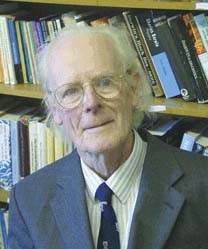 John Maynard Smith 1920 - 2004 |
John Maynard Smith
reviews by Gert Korthof |
"The leading modern evolutionary theorist is John Maynard Smith"
Colin Patterson (1999) Evolution, p. 154
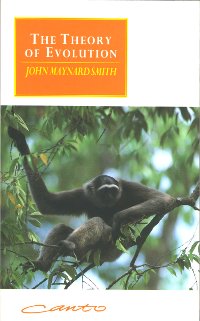 "Few people in the world are better qualified than John Maynard Smith to explain evolution to us, and no subject more than evolution deserves such a talented teacher.
"Few people in the world are better qualified than John Maynard Smith to explain evolution to us, and no subject more than evolution deserves such a talented teacher.Like Darwin himself, Maynard Smith knows that his story is intrinsically interesting enough and important enough to need no more than clear, patient, honest exposition. The new Introduction itself is an elegant essay which can be recommended in its own right as a summary of important recent developments in evolutionary theory." Richard Dawkins in the Foreword to the Canto Edition. This book is a classic with a history of more than 40 years: it was first published in 1958. The new foreword (1993) to the third edition of 1975, is a 25 page summary of all important new findings since 1975. For critics and students of evolution alike this summary is a must. JMS intended the book as a popular account of the modern synthesis. (it is a pity that it never was published with colour illustrations). It starts with: "The central idea that underlies this book is that the origin of new heritable variation is not adaptive."in a paragraph Molecular Weismannism and contains a discussion of the experiments of Cairns and Hall, the experiments upon which Lee Spetner (1) based his Non Random Evolutionary Hypothesis. Together with Chapter 4 Weismann, Lamarck, and the Central Dogma this is essential background knowledge for evaluating claims of the critics of the Central Dogma. JMS is an ultra-Darwinist according to Niles Eldredge. He is not an atheist in his books, nor is he concerned with creationism. We do not find the connection of a defence of evolution with an attack on creation or design, which is so characteristic of the writings of Richard Dawkins. It is difficult to find another authoriative book of this size and prize about the theory of evolution (but see 6). However JMS is rather technical, unlike Richard Dawkins. So some effort is needed, but the reward is the best insight in the theory of evolution one will ever find. New chapters were added in the 1975 edition: the origin of life (6), chromosomes (7), protein polymorphism (11). Even after many years I found very valuable insights which one won't find expressed with such lucidity in modern books (10). The only complaint I have is that there is no chapter about common descent (tree of life). |
|
|
DID DARWIN GET IT RIGHT ? Essays on Games, Sex and Evolution.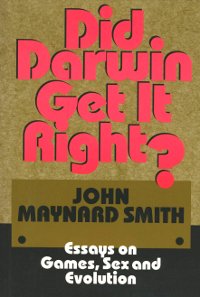 The essays in this volume were published between 1968 to 1986, except Why Sex?, which was specially written for this volume and is an attempt to summarise JMS ideas for a general readership. This volume is a useful addition to his Theory of evolution. The four chapters in Part 3: Did Darwin Get It Right? and chapter 20 (Part 4) are the most interesting for the critics of evolution. Chapter 15 Palaeontology at the High Table, Chapter 16 Current Controversies in Evolutionary Biology and Chapter 17 Did Darwin get it Right? describe what the critics of orthodox neo-Darwinism, S.J. Gould and N. Eldredge, actually claim ('punctuated equilibria', 'stasis', 'species selection', 'developmental constraints'). Chapter 18 Do we need a new Evolutionary Paradigm? is a review of Ho & Saunders' Beyond Neo-Darwinism. Ho & Saunders are often cited by the critics of evolution. Their book is a collection of essays of authors who do not see themselves as orthodox Darwinists. JMS shortly discusses most of them. The fascinating work of Sidney Fox is discussed with approval (polymerisation of amino acids in the absence of living organisms). This work is relevant to non-Darwinian processes because there is no need for hereditary replication and natural selection. Elizabeth Vrba's contribution 'differs from most in this volume by being at the same time rational and about evolution' (!). The contribution of Nelson and Platnick has no relevance to Darwinism according to JMS. They argue about what we should call things (cladistic taxonomy) and not what the world is. The essay of Saunders is a useful one, but the things that are said, have also been said by neo-Darwinists. J.W. Pollard argues for the 'inheritance of acquired characters' based on the work of E.J. Steele (2). JMS has sympathy for those views, but remarks that the inheritance of acquired characters would imply that we would all be born with cancer. Well, do we need a new evolutionary paradigm? Is JMS fair in his judgement? If the authors of Beyond Neo-Darwinism claim a new evolutionary paradigm is needed, then JMS is justified to judge their contributions accordingly. He finds some authors to be right, some to be wrong and some irrelevant to the central claim of the book. But JMS conclusion is that the volume does not convince him that a new evolutionary paradigm is needed. I find that Nelson and Platnick are too easily dismissed. Ho and Saunders claim that Kimura's neutral theory has undermined Darwinism, is too easily rejected by calling Kimura a neo-Darwinist. The Limitations of Evolution Theory (Ch 20) is an interesting essay. It does not happen very often that a leader in the field talks about limitations of the central paradigm of the field. If I understand JMS correctly he admits that the neo-Darwinian theory of evolution is inadequate in some respects and that it is a hypothesis, not a fact. At the same time, JMS claims to be an unrepentant neo-Darwinist. In evolution theory it is rarely possible to think of a single decisive experiment or observation which will settle a controversy. |
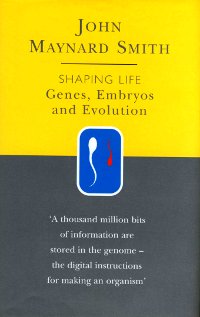 "Evolutionary theory is largely concerned with changes in the frequencies of genes in populations, brought about by mutation, natural selection and other processes. What we observe in evolution are changes in the forms of animals and plants. To link theory and observation, we need to know how changes in genes cause changes in morphology. And that requires an understanding of development" (p3). The theme of the book SHAPING LIFE is the interaction of development, genetics and evolution or: what drives development: information or self-organization? And what is the relative importance of both? Fascinating stuff. Very condensed and abstract writing. After having read some other books in this field, going back to this booklet is rewarding. An important participant of the discussion complexity - evolution, although alluded to several times, is absent: Stuart Kauffman (3). |
|
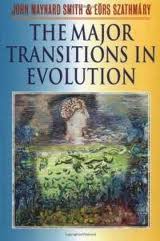 1995 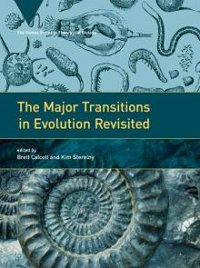 'Major Transitions in Evolution Revisited', Brett Calcott and Kim Sterelny (editors), 2011 |
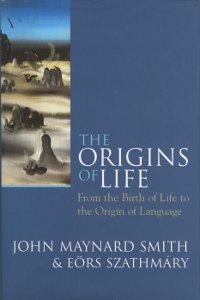 THE ORIGINS OF LIFE is aimed at a general readership. It is a completely rewritten and abridged version of The Major Transitions in Evolution (1995) (11) which was aimed at professional biologists. Together with Eörs Szathmáry they cover the whole of evolutionary theory from first forms of life to the origin of language. This book is a goldmine. Every page contains superb insights into crucial aspects of life and Darwinian evolution. Every concept is illustrated with relevant data without going in too much detail. There is no place for wild speculations. Very condensed but clear writing, not too much technical terms, so it is perfectly readable. The introductory chapter is splendid. The authors attack the hardest and most profound questions in evolutionary biology. They do not solve every problem, but what they have written is of long lasting importance. It is hard to see if there ever will be a rival book that explains the origins and evolution of life so clearly and so profoundly.
THE ORIGINS OF LIFE is aimed at a general readership. It is a completely rewritten and abridged version of The Major Transitions in Evolution (1995) (11) which was aimed at professional biologists. Together with Eörs Szathmáry they cover the whole of evolutionary theory from first forms of life to the origin of language. This book is a goldmine. Every page contains superb insights into crucial aspects of life and Darwinian evolution. Every concept is illustrated with relevant data without going in too much detail. There is no place for wild speculations. Very condensed but clear writing, not too much technical terms, so it is perfectly readable. The introductory chapter is splendid. The authors attack the hardest and most profound questions in evolutionary biology. They do not solve every problem, but what they have written is of long lasting importance. It is hard to see if there ever will be a rival book that explains the origins and evolution of life so clearly and so profoundly.The central idea of the book is that the path of evolution on Earth is characterised by major transitions. These major transitions are in fact the most important innovations of life.
Further Reading:
| ||||||||||||||||||||||||||||||||||||||||||||||||||
Youtube
Notes
Further Reading
|
|||||||||||||||||||||||||||||||||||||||||||||||||||
| Korthof blogspot | homepage: wasdarwinwrong.com | https://wasdarwinwrong.com/kortho34.htm |
| Copyright © 1999 G.Korthof . | First published: 24 Jan 1999 | Last update: 5 Jul 2021 F.R./Notes: 20 Mar 2025 |